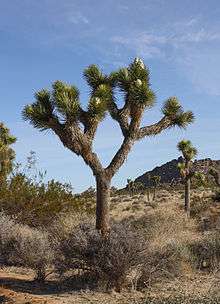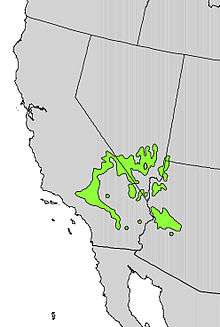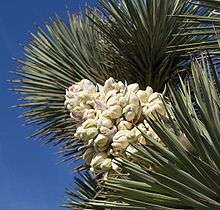Yucca brevifolia
| Joshua tree | |
|---|---|
 | |
| In Joshua Tree National Park, California | |
| Scientific classification | |
| Kingdom: | Plantae |
| Clade: | Angiosperms |
| Clade: | Monocots |
| Order: | Asparagales |
| Family: | Asparagaceae |
| Subfamily: | Agavoideae |
| Genus: | Yucca |
| Species: | Y. brevifolia |
| Binomial name | |
| Yucca brevifolia Engelm. | |
 | |
| Natural range | |
| Synonyms[1] | |
| |
Yucca brevifolia is a plant species belonging to the genus Yucca. It is tree-like in habit, which is reflected in its common names: Joshua tree, yucca palm, tree yucca, and palm tree yucca.[2][3][4][5]
This monocotyledonous tree is native to arid southwestern North America in the states of California, Arizona, Utah, and Nevada, where it is confined mostly to the Mojave Desert between 400 and 1,800 m (1,300 and 5,900 ft) elevation. It thrives in the open grasslands of Queen Valley and Lost Horse Valley in Joshua Tree National Park. A dense Joshua tree forest also exists in Mojave National Preserve, in the Cima Dome, (Cima, California), northeast of Kingman, Arizona in Mohave County, Arizona, as well as along U.S. 93 between the towns of Wickenburg and Wikieup, and designated as the Joshua Tree Parkway of Arizona.
Taxonomy
The name Joshua tree was given by a group of Mormon settlers crossing the Mojave Desert in the mid-19th century. The tree's unique shape reminded them of a Biblical story in which Joshua reaches his hands up to the sky in prayer.[6][7][8] Ranchers and miners who were contemporary with the Mormon immigrants used the trunks and branches as fencing and for fuel for ore-processing steam engines. It is also called izote de desierto (Spanish, "desert dagger").[9] It was first formally described in the botanical literature as Yucca brevifolia by George Engelmann in 1871 as part of the Geological Exploration of the 100th meridian or Wheeler Survey.[10]
In addition to the autonymic subspecies Yucca brevifolia subsp. brevifolia, two other subspecies have been described:[11] Yucca brevifolia subsp. jaegeriana (the Jaeger Joshua tree or Jaeger's Joshua tree or pygmae yucca) and Yucca brevifolia subsp. herbertii (Webber's yucca or Herbert Joshua tree), though both are sometimes treated as varieties[9][12][13] or forms.[14]
Growth and development
Joshua trees are fast growers for the desert; new seedlings may grow at an average rate of 7.6 cm (3.0 in) per year in their first ten years, then only about 3.8 cm (1.5 in) per year.[15] The trunk consists of thousands of small fibers and lacks annual growth rings, making it difficult to determine the tree's age. This tree has a top-heavy branch system, but also what has been described as a "deep and extensive" root system, with roots reaching up to 11 m (36 ft).[2] If it survives the rigors of the desert, it can live for hundreds of years; some specimens survive a thousand years. The tallest trees reach about 15 m (49 ft). New plants can grow from seed, but in some populations, new stems grow from underground rhizomes that spread out around the parent tree.
The evergreen leaves are dark green, linear, bayonet-shaped, 15–35 cm long and 7–15 mm broad at the base, tapering to a sharp point; they are borne in a dense spiral arrangement at the apex of the stems. The leaf margins are white and serrate.

Flowers appear from February to late April, in panicles 30–55 cm tall and 30–38 cm broad, the individual flowers erect, 4–7 cm tall, with six creamy white to green tepals. The tepals are lanceolate and are fused to the middle. The fused pistils are 3 cm tall and the stigma cavity is surrounded by lobes. The semi-fleshy fruit that is produced is green-brown, elliptical, and contains many flat seeds. Joshua trees usually do not branch until after they bloom (though branching may also occur if the growing tip is destroyed by the yucca-boring weevil), and they do not bloom every year. Like most desert plants, their blooming depends on rainfall at the proper time. They also need a winter freeze before they bloom.
Once they bloom, the trees are pollinated by the yucca moth, which spreads pollen while laying her eggs inside the flower. The moth larvae feed on the seeds of the tree, but enough seeds are left behind to produce more trees. The Joshua tree is also able to actively abort ovaries in which too many eggs have been laid.
Distribution and habitat
Yucca brevifolia is endemic to the Southwestern United States with populations in western Arizona, southeastern California, southern Nevada, and southwestern Utah. This range mostly coincides with the geographical reach of the Mojave Desert,[2] where it is considered one of the major indicator species for the desert. It occurs at altitudes between 400 and 1,800 m (1,300 and 5,900 ft).[16]
Conservation status
Joshua trees are one of the species predicted to have their range reduced and shifted by climate change.[17] There is concern that they will be eliminated from Joshua Tree National Park, with ecological research suggesting a high probability that their populations will be reduced by 90% of their current range by the end of the 21st century,[18][19] thus fundamentally transforming the ecosystem of the park. There is also concern about the ability of the species to migrate to favorable climates due to the extinction of the giant Shasta ground sloth (Nothrotheriops shastensis) 13,000 years ago; ground sloth dung has been found to contain Joshua tree leaves, fruits, and seeds, suggesting that the sloths might have been key to the tree's dispersal.[18][19]
Uses and cultivation

Different forms of the species are cultivated, including smaller plants native from the eastern part of the species range. These smaller plants grow 2.5 meters tall and branch when about a meter tall.[20]
Cahuilla Native Americans, who have lived in the southwestern United States for generations, identify this plant as a valuable resource and call it "hunuvat chiy’a" or "humwichawa". Their ancestors used the leaves of Y. brevifolia to weave sandals and baskets, in addition to harvesting the seeds and flower buds for meals.
Yucca tree roots have saponin glycosides.[21]
See also
 Trees portal
Trees portal
References
- ↑ "Yucca brevifolia". Tropicos.
- 1 2 3 Gucker, Corey L. (2006). "Yucca brevifolia". Fire Effects Information System. U.S. Department of Agriculture, Forest Service, Rocky Mountain Research Station, Fire Sciences Laboratory. Retrieved 2008-12-20.
- ↑ "Yucca brevifolia". BioImages. Vanderbilt University. Retrieved 2014-12-06.
- ↑ "Joshua Tree, Yucca brevifolia". Arizona Wild Flowers. Delange. Retrieved 2012-03-30.
- ↑ Watson, Sereno (1871). "United States Geological Exploration of the Fortieth Parallel". Botany. 5 (464): 496. Bibcode:1878Natur..18..538J. doi:10.1038/018538a0.
- ↑ "Joshua Tree National Park". Nature and Science: Joshua Trees. National Park Service. Retrieved 2013-05-27.
- ↑ "Joshua Tree National Park". National Geographic Society. Retrieved 2013-05-27.
- ↑ "Joshua Tree (Yucca brevifolia)". Meet the Species: All Species. The California Phenology Project, USA National Phenology Network. Retrieved 2013-05-27.
- 1 2 "Yucca". Itis Report. Integrated Taxonomic Information System. Retrieved 2012-03-30.
- ↑ "Yucca brevifolia Engelm.". International Plant Names Index. Retrieved 2008-12-20.
- ↑ "Yucca species". Yuccaagavaceae.com. Retrieved 2012-03-30.
- ↑ Grandtner, Miroslav M. (2005). Elsevier's Dictionary of Trees - North America. Amsterdam: Elsevier. p. 973. ISBN 0-444-51784-7.
- ↑ Magney, David L. (2005-09-19). "Checklist of Ventura County Rare Plants" (PDF). California National Plant Society, Channel Islands Chapter. Retrieved 2012-03-30.
- ↑ Eggli, Urs (2001). Monocotyledons. Berlin: Springer. pp. 90–91, 100. ISBN 978-3-540-41692-0.
- ↑ Keith, Sandra L (1982). "A tree named Joshua". American Forests. 88 (7): 40–42.
- ↑ Gossard, G (1992). The Joshua Tree, a Controversial, Contradictory Desert Centurion. Yellow Rose Publications.
- ↑ Shafer, Sarah L.; Bartlein, Patrick J. & Thompson, Robert S. (2001). "Potential changes in the distributions of western North America tree and shrub taxa under future climate scenarios" (PDF). Ecosystems. 4 (3): 200–215. doi:10.1007/s10021-001-0004-5. Retrieved 2013-03-06.
- 1 2 Cole, Kenneth L.; Ironside, Kirsten; Eischeid, Jon; Garfin, Gregg; Duffy, Phillip B.; Toney, Chris (2011). "Past and ongoing shifts in Joshua tree distribution support future modeled range contraction" (PDF). Ecological Applications. 21 (1): 137–149. doi:10.1890/09-1800.1. PMID 21516893.
- 1 2 "Outlook Bleak for Joshua Trees". National Public Radio. 2008-02-04. Retrieved 2012-03-30.
- ↑ Harlow, Nora; Jakob, Kristin, eds. (2003). Wild lilies, irises, and grasses: gardening with California monocots. Berkeley: University of California Press. p. 215. ISBN 978-0-520-23849-7.
- ↑ Burdock, George A. (2005). Fenaroli's handbook of flavor ingredients. Boca Raton, Fla.: CRC Press. p. 1913. ISBN 0-8493-3034-3.
Further reading
- Cornett, J. W. (1999). The Joshua Tree. Palm Springs, California: Natural Trails Press.
External links
| Wikimedia Commons has media related to: |
- Cal Flora Database: Yucca brevifolia (Joshua tree)
- Jepson Manual Treatment: Yucca brevifolia
- eFloras.org—Flora of North America: Yucca brevifolia
- eFloras.org: Range Map
- Joshua Tree National Park website
\